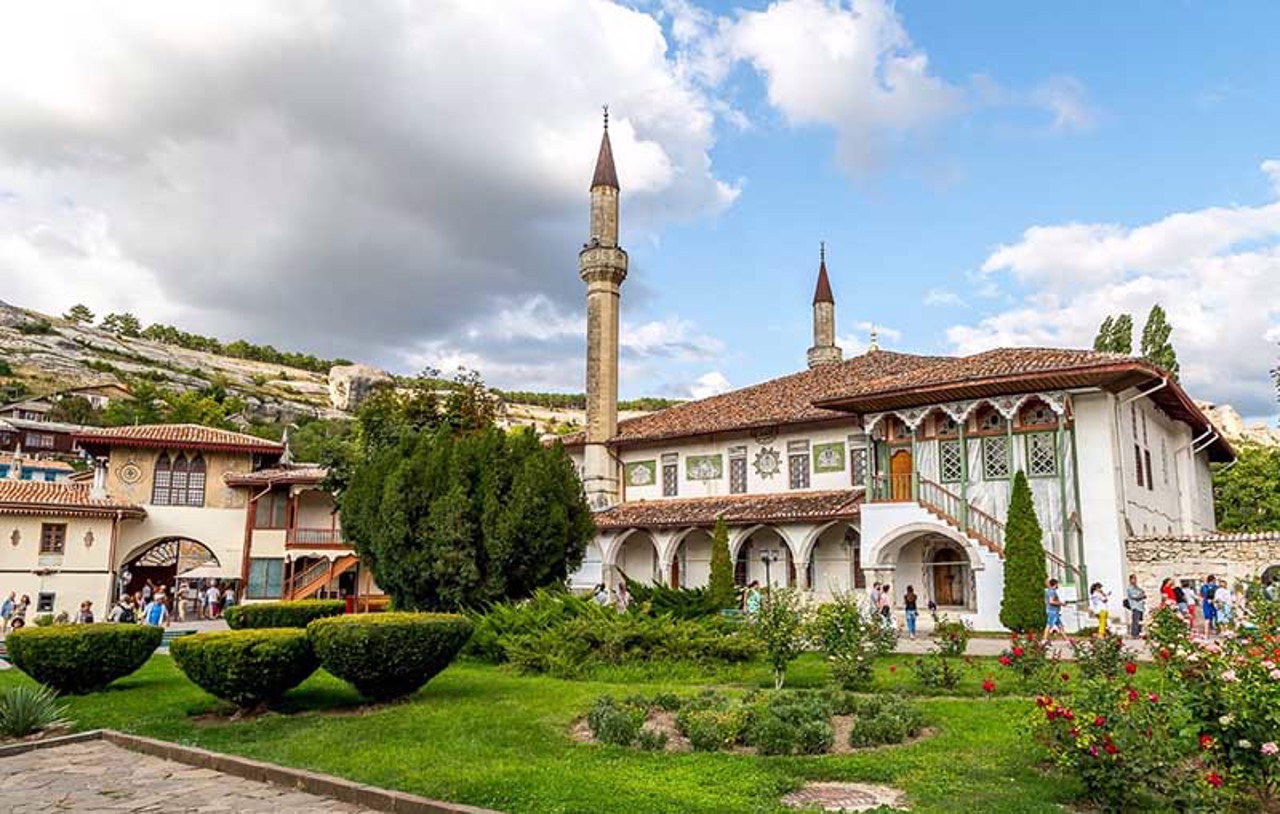Functional temporarily unavailable
Bakhchysarai
Travel guide online Bakhchysarai
General information about Bakhchysarai
The city Bakhchysarai is the former capital of the Crimean Khanate, the residence of the khans from the 16th to the 18th centuries.
According to legend, it was founded by Khan Menhli-Geray, 2 km from the former capital Salachik, the construction of the palace was completed under Sahib Geray. The name translates as "palace surrounded by gardens". For two centuries it was the center of the political, spiritual and cultural life of the state of the Crimean Tatars.
In 1736, it was completely burned down by the Russian army under the command of Minich, the khan's palace was restored to its original form during the rebuilding of the city, and a museum was later created.
Before the deportation of 1944, Bakhchysarai was one of the main cultural centers of the Cri ...
The city Bakhchysarai is the former capital of the Crimean Khanate, the residence of the khans from the 16th to the 18th centuries.
According to legend, it was founded by Khan Menhli-Geray, 2 km from the former capital Salachik, the construction of the palace was completed under Sahib Geray. The name translates as "palace surrounded by gardens". For two centuries it was the center of the political, spiritual and cultural life of the state of the Crimean Tatars.
In 1736, it was completely burned down by the Russian army under the command of Minich, the khan's palace was restored to its original form during the rebuilding of the city, and a museum was later created.
Before the deportation of 1944, Bakhchysarai was one of the main cultural centers of the Crimean Tatars. Now it is a popular tourist attraction.
Nearby - the cave city of the Karaites Chufut-Kale and the cave Assumption Monastery.
Місто Бахчисарай - колишня столиця Кримського ханства, резиденція ханів з XVI по XVIII століття.
За легендою, засноване ханом Менглі-Ґераєм в 2 кілометрах від колишньої столиці Салачик, будівництво палацу завершено при Сахіб Ґера́ї. Назва перекладається як "оточений садами палац". Протягом двох століть був центром політичного, духовного й культурного життя держави кримських татар.
У 1736 році був повністю спалений російською армією під командуванням Мініха, ханський палац відновлено у первісному вигляді в ході відбудови міста, згодом створено музей.
До депортації 1944 року Бахчисарай був одним з головних культурних центрів кримських татар. Зараз - популярний туристичний об'єкт.
Поруч - печерне місто караїмів Чуфут-Кале та печерний Успенський монасти ...
Місто Бахчисарай - колишня столиця Кримського ханства, резиденція ханів з XVI по XVIII століття.
За легендою, засноване ханом Менглі-Ґераєм в 2 кілометрах від колишньої столиці Салачик, будівництво палацу завершено при Сахіб Ґера́ї. Назва перекладається як "оточений садами палац". Протягом двох століть був центром політичного, духовного й культурного життя держави кримських татар.
У 1736 році був повністю спалений російською армією під командуванням Мініха, ханський палац відновлено у первісному вигляді в ході відбудови міста, згодом створено музей.
До депортації 1944 року Бахчисарай був одним з головних культурних центрів кримських татар. Зараз - популярний туристичний об'єкт.
Поруч - печерне місто караїмів Чуфут-Кале та печерний Успенський монастир.
Сплануй своє перебування у Bakhchysarai
What to see and where to go in Bakhchysarai
Tourist attractions and museums of Bakhchysarai

Chufut-Kale
Castle / fortress
It arose on a mountain plateau around the V-VI centuries as a fortified settlement on the border of Byzantine possessions. The main population consisted of Alans, then Kipchaks.
Since the 13th century, taken by the Tatars after a long siege and named Kirk-Or, the city was part of the Crimean Khanate (it was the residence of the khan). In the 15th century, Karaites settled here, giving the city the name Chufut-Kale ("Jewish fortress").
Left by residents until the beginning of the 20th century. In the 20th century, Chufut-Kale became a popular tourist center. Three fortress walls with a gate and towers, the mausoleum of the daughter of the Golden Horde Khan Tokhtamysh Dzhanyke-khanym (year 1437), two Karaim kenas, the estate of the historian Avraham Firkovych, and other buildings have been preserved. Near the entrance is a unique siege well.

Eski-Durbe
Architecture
Eski-Durbe (from Crimean Tatar - "Old Mausoleum") - the oldest tomb of Bakhchysarai. Built in the 15th century - long before the Bakhchysarai Palace.
According to legend, a ruler who owned the valley before the arrival of the Girays, whose name has already been forgotten, is buried here.
In shape, Eski-Durbe is a cube with a spherical dome. The square arched courtyard with a fountain can only be accessed from the tomb.

Medieval Aziz
Architecture
The complex of medieval Aziz (religious buildings, symbolic tombs, mausoleums) is located in Bakhchysarai in the area of the old Tatar market.
Previously, a large cemetery of the city of Eski-Yurt was located here. The cubic tomb of durbe Ahmed-bey (1577), the mausoleum of durbe Muhammad-bey in the form of an octagonal yurt (16th century), the elegant Aziz of Khan Muhammad-Girey (17th century), the remains of a prayer hall (tekke) of wandering Muslim monks (dervishes) in the form of an octagonal tower, to which 12 steps lead (16th-17th centuries) have survived to this day.
Reviews Bakhchysarai
Geographical information about Bakhchysarai
| {{itemKey}} | {{itemValue}} |
|---|---|
| Region |
Autonomous Republic of Crimea |










